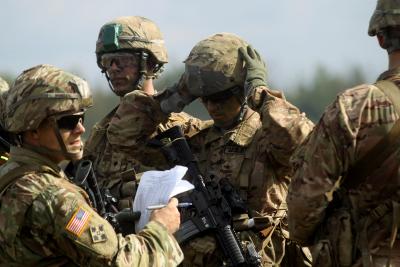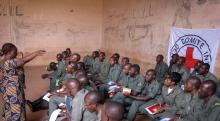Case Prepared by Luke Anderson, J.D. Student at Emory University School of Law, under the supervision of Professor Laurie Blank, Emory University School of Law.
A. U.S. SENATE AND DEPARTMENT OF DEFENSE EMPHASIZE THE IMPORTANCE OF COMPLIANCE WITH LAW OF WAR, INCLUDING THE 1954 HAGUE CONVENTION FOR THE PROTECTION OF CULTURAL PROPERTY IN THE EVENT OF ARMED CONFLICT
[Source: Department of Defense, Report on Cultural Preservation in Armed Conflict, submitted pursuant to H.R. 115-200, accompanying H.R. 2810, at 201 (2018)]
The [Senate] committee recognizes Department of Defense policy, including the Department Directive 2311.01E, “Department of Defense Law of War Program,” which states it is Department policy to comply with the law of war during all armed conflicts and in all other military operations, including treaties and international agreements to which the United States is a party, such as the 1954 Hague Convention for the Protection of Cultural Property in the Event of Armed Conflict. The committee is encouraged by actions the Department has taken to protect cultural property, including its training, education, and cataloging efforts. […]
Under the DoD [Department of Defense] Law of War Program, various offices and agencies within the Department of Defense, including the Military Departments, play a role in ensuring DoD’s implementation of, and compliance with, the law of war, including the 1954 Hague Convention. For example, the DoD General Counsel is responsible for exercising primary staff responsibility for the DoD Law of War Program, which establishes policies related to ensuring DoD’s implementation of, and compliance with, the law of war obligations of the United States, including the 1954 Hague Convention […].
Several sections in the DoD Law of War Manual focus on the protection of cultural property, and the Manual includes a comprehensive description of U.S. legal obligations under the 1954 Hague Convention. The Manual helps implement the requirement under Article 25 of the Convention related to disseminating information about the Convention to the armed forces, and the Manual facilitates a consistent understanding of the Convention’s requirements throughout the Department […]
DoD collaborates with other U.S. Government departments and agencies involved in the protection of cultural property. This includes the Department of State’s Bureau of Educational and Cultural Affairs, which chairs both the Interagency Cultural Heritage Coordinating Committee and the congressionally mandated Cultural Antiquities Task Force.
The Cultural Antiquities Task Force works to increase cooperation among law enforcement agencies and the State Department on cultural heritage challenges and produces emergency “Red Lists of Antiquities at Risk,” which are specially designed guides for customs officials, police officers, museums, art dealers, and collectors, to help them recognize the general types of archaeological, ethnographic, and ecclesiastical objects that have been looted from cultural sites, stolen from museums and churches, and illicitly trafficked. “Red Lists” have been produced for Iraq, Syria, Afghanistan, West Africa, Egypt, Haiti, Colombia, China, Central America, Mexico, Cambodia, and Peru.
[…]
B. INCLUSION OF PROTECTION OF CULTURAL PROPERTY IN OPERATIONAL TRAINING
[Source: Maj. Kristoffer T. Mills and Laurie Rush, Integration of Cultural Property Protection into a Decisive Action Training Exercise, Military Review, 2017, p. 106]
[…]
In September 2016, the G-9 (civil-military operations) office, 10th Mountain Division (Light Infantry) initiated a unique partnership with the Cultural Resources Branch (CRB) at Fort Drum, New York. The deputy G-9, Maj. Kristoffer Mills, consulted with the installation’s Cultural Resources Program manager (CRM), Dr. Laurie Rush, to gain a better understanding of the culturally significant sites within the Fort Drum training area while planning for a brigade-level exportable combat training capability exercise, which is a field training exercise based on the Decisive Action Training Environment. This particular exercise, Mountain Peak 17-02, was conducted on Fort Drum to prepare the unit for a subsequent training rotation to the Joint Readiness Training Center at Fort Polk, Louisiana.
[…]
In contrast to many other DOD installations, Fort Drum’s CRP emphasizes the use of archaeological sites and cultural property in the training areas to provide realistic training opportunities. It makes no sense to prevent U.S. military personnel from operating around significant cultural property on training lands at domestic U.S. installations when they are preparing to deploy to some of the most archaeologically rich and sensitive areas of the world […]. Recognizing the significance and importance of training with regard to cultural property, the Department of the Army endorsed the use of installation cultural resources as training assets in its most recent guidance to cultural resources managers.
[…]
For example, when soldiers reported that Iraqi insurgents were using headstones as firing points, the Cultural Resources Team (CRT) constructed culturally reminiscent replica cemeteries and added them to urban sprawl and urban terrain training sites on Fort Drum so that dealing with such scenarios could be practiced. And, after the global news media featured reports of damage to the ancient city of Babylon by U.S. and Polish forces in 2004, the CRT constructed mock ruins in the training areas to offer field training opportunities to identify, avoid, and respect ancient places as well as sites regarded as sacred by indigenous peoples during the course of military operations. […]
The greatest challenge when transforming an area such as Sterlingville is to create protection for historic features while retaining evidence for the soldiers that they are operating in an area designated as historic… The Blue Shield, an international symbol of protected cultural property per the 1954 Hague Convention for the Protection of Cultural Property in the Event of Armed Conflict, was also added to some of the signage to provide familiarization. The trainers also eventually added some wooden structures to the properties where the features had been completely covered by the fabric and fill, so that the village began to once again take on the appearance of a community […]
It is important to note that the map of protected sites on Fort Drum and similar maps for all U.S. domestic training installations are analogous to the cultural property inventories of protected sites and institutions that operations planners must consider for all forward operations under not just 1954 Hague but also laws of armed conflict, domestic law including Section 402 of the National Historic Preservation Act, and DOD and Army regulations such as U.S. Central Command Environmental Regulation 200-2, Environmental Quality: CENTCOM Contigency Environmental Guidance. These inventories contribute to the “no strike” component of the targeting process, so the opportunity to implement target avoidance during an exercise is another valuable aspect of the efforts to integrate such exercises into Fort Drum training[…]
The successful integration of cultural property protection during the brigade exercise at Fort Drum was replicated during a second exercise at Fort Polk, Louisiana, to support 3rd Brigade, 10th Mountain Division.
DISCUSSION
I. Classification of the Conflict and Applicable Law
1.Does the classification of the situation matter to determine whether IHL was respected in this case?
II. Protection of Cultural Heritage
2. How is cultural heritage protected in times of armed conflicts? Does it benefit from the general protection afforded to civilian objects? Which rules on the conduct of hostilities are applicable regarding cultural heritage? Does it benefit from special protection under IHL? If yes, what does it entail? (
Hague Regulations, Arts 27 and
56;
Hague Convention for the Protection of Cultural Property, Arts 4,
19;
P I, Arts 52 (2),
53;
P II, Art. 16;
CIHL, Rules 8,
38,
39,
40)
III. Elements Contributing to Respect for IHL
4. Is there a military and political interest for the Parties to a conflict to protect cultural heritage? Why? In your opinion, can protection of cultural property help to gain the support of the local population? Do you think that violations of IHL involving cultural heritage of mankind can have greater international resonance and potential response from the international community? Can these considerations serve as an incentive to train their armed forces during peacetime, so that these rules are not violated if and when they engage in armed conflict?
5. How can a general understanding of the cultural traditions, buildings and artifacts of the other parties to a conflict help promote protection of cultural property?
6. How do strategies such as training on no-strike lists, distribution of training materials, and interaction with cultural protection teams lead to greater implementation of IHL on the ground?






